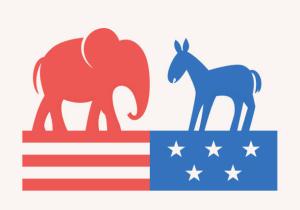
As we approach the mid-term elections, we’re all seeing increasingly dystopian political ads everywhere. On billboards, in the mail, and on commercials. If your kids are anything like mine, they are asking questions. (And, if your team is in the World Series – go, Phillies! – they’re watching extra television, which means they’re asking extra questions).
Mommy, What are Democrats and Republicans?
Years ago, my pre-school age kids asked which were the good guys: Democrats or Republicans? My husband and I explained that there were good and bad guys (and gals) on each side. We explained that some people are neither Democrats nor Republicans, because lots of people are independents. In fact, we told them, Mommy and Daddy would both be independents if independents in Pennsylvania could vote in the primary elections (that is, help the Democrats and the Republicans decide which person will be the one running for each office).
As it stands, though, Mommy is a Democrat that doesn’t like what a lot of other Democrats today say and do. And Daddy is a Republican that doesn’t like what a lot of other Republicans today say and do. That means some people would call Mommy a DINO (Democrat in name only) and Daddy a RINO (Republican in name only).
For a while, that was good enough. Our little boys were (as we probably all should be) more interested in actual dinosaurs and rhinoceri than in either political party.
But now, these elementary schoolers want to know: If there are some good guys and some bad guys in each party, how did you decide which party to be in? And what do we do about the bad guys in each one?
Those of us without a political home—caught in the vast window of sanity between two increasingly crazy ideologies—each have our own answers to these questions. What follows are mine.
How did you decide which party to be in?
In 2005, when I turned 18, I registered Democrat. My parents were (and are) both Democrats, second generation Americans whose grandparents had come from Italy and Romania, respectively, and who identified with what was, until the 1990’s and even a bit beyond, the Democrats’ largely economic appeal to working people.
Although my maternal grandfather had pulled his family into the middle and then upper-middle class in which my mom grew up, and although my dad had done the same for his own family, neither was a business owner or a country club member. My Jewish maternal grandfather passed away when I was a small child, but from what I have heard about him, he and my Catholic father, though different in myriad ways, were two peas in a pod in that, although they achieved economic security, they stayed culturally working-class.
My mom and I, each the oldest child of a self-made, immigrant-oriented, non-WASP Democrat, were raised to understand our roots. So, each of us registered Democrat because that’s just what you did if you cared about working people (and especially working people of color, with whom the Democrats had spearheaded the Civil Rights movement). Democrats were for the working-class; Republicans were for the rich.
By the time that I cast a ballot for Barack Obama in 2008 (the first presidential election in which I was old enough to vote), I understood that the class-based distinctions between the two parties were beginning to disintegrate.
In the 1990’s and 2000’s, things were shifting such that cultural differences between the parties, rather than economic ones, were beginning to take center stage. No longer were there many pro-life Democrats or pro-choice Republicans. No longer were the owners of big businesses near-exclusively Republican, or working-class Americans near-exclusively Democrat. The final vibration of the original sexual revolution—gay marriage—was a hotly contested issue that broke more along party lines than any economic issue did. Even so, in my early 2000’s nascent political consciousness, Democrats remained the party of working people, and Republicans remained the party of tax cuts for the rich.
In 2008, Barack Obama held the cultural line just enough—not by underselling his own more left-leaning cultural views, but by both signaling and embodying a common oneness as Americans with those that did not share them—to earn the pro-life, pro-family, pro-poor, practicing Catholic vote of 21-year-old me.
My now-husband (then-boyfriend) imbibed the new landscape—parties divided more by culture than by economics—faster than I did. The son of Liberian immigrants who (like my great-grandparents and countless immigrants before them) registered Democrat, he grew up in East Cleveland, the poorest municipality in the state of Ohio, where nearly all the residents are African American.
By the time my husband was growing up, in the 1990’s and early 2000’s, Democrats had been in control of the area for nearly fifty years. During that time, terrible public schools, chronic disinvestment, and endemic violent crime had decimated the neighborhood where his parents raised their children. My in-laws found a way to put their children through Catholic school; made sure that they had access to educational and cultural opportunities in other parts of the metropolitan area; and worried, like all the other parents in the neighborhood, about their kids’ safety.
When he turned 18 in 2004, my husband registered Republican. Partly because he wondered how much worse anyone else could really be, given the visible decline that had occurred even during his own short lifetime. And partly because he noticed that all the things his parents had taught him to believe in, and that would have helped his family—school choice, equality of opportunity, public safety, traditional religious values—were being spoken to more consistently by the Republican party than by the Democratic one.
Meanwhile, the Republicans of the George W. Bush era had moved the cultural line on race just enough—by promising immigration reform that favored Latin American immigration, by collaborating with African American religious leaders, and by paying attention to issues like the racial achievement gap in education that plagued neighbors whose parents had not been able to access parochial education—to earn my husband’s GOP registration.
My husband and I got married in December 2012, just after the final presidential election in which the old economically rooted differences between the parties took up any airtime.
Today, the political parties do not track with any particular economic views, but they do track with myriad cultural ones. Just as there were once pro-life and pro-choice Democrats, there are now corporate Democrats and democratic socialist Democrats, nearly all of whom are pro-choice, anti-gun, for gender ideology, and so on. Just as there were once pro-life and pro-choice Republicans, there are now corporate Republicans and populist Republicans, nearly all of whom are pro-life, pro-gun, and against gender ideology, and so on.
This focus on culture rather than on economics has led to rancor, polarization, and political segregation. For example, although my inter-racial marriage now meets with the approval of 94% of American parents, my inter-party marriage meets with the approval of just 45%.
This makes sense, because of how closely and intimately people hold cultural issues, and how comparatively clinically they hold economic ones.
After all, there is some virtue to the old Democratic focus on unions, fair wages, and social safety nets; and there is also some virtue to the old Republican focus on fiscal conservatism, business orientation, and job creation. In the end, a healthy society does need both.
Today, each party contains both economic orientations within itself, and is divided from the other party over issues that feel a lot more personal and zero sum than tax rates. This is a breeding ground for cultural extremism.
What do we do about the bad guys in each party?
The 2008 Democratic party that was culturally to my left but did not alienate me due to my cultural moderation and religiosity was, in the 2010’s and culminating in 2020, slowly hijacked by people that find my utterly mainstream views on many matters off-putting and offensive. These people have been around since the 1960’s, but not until the 2010’s did their nonsense find its way out of the universities and into the rhetoric of a major political party.
The 2004 Republican party that was looking to build a more racially and religiously inclusive coalition for conservative values and embraced my husband was, from 2012 to 2016, quickly hijacked by people that were willing to capitalize on racial divisiveness, racist nostalgia, and crude anti-immigrant rhetoric to alienate people like him while rallying former Democrats and first-time voters. People that thrill to these sorts of low, tribal dog whistles have been around forever, but both parties had together kept them successfully marginalized from respectable discourse for many decades.
Today, the average voter in each party is a reasonable person, but many in the leadership and activist classes are lost to reason on many levels. So, there are essentially four parties: reasonable Democrats, reasonable Republicans, unreasonable Democrats and unreasonable Republicans.
Reasonable Democrats and reasonable Republicans actually agree on most things. Like, that the sky is blue; that hard work should be rewarded; that women are humans with XX chromosomes; that marriages between two adults of any sexes should be legally recognized; that tests are a good way to assess students’ learning; that law-abiding citizens should be protected from violent and property crime; that we should judge people by the content of their character, not the color of their skin; that free speech and religious freedom are essential; that election-denying is bad for democracy; that people of every race, and of all faiths and no faith, are real Americans; and that to be an American is a blessing and an opportunity.
Reasonable Democrats and reasonable Republicans might disagree about when in pregnancy to draw the line on abortion, who can have gun permits, how much to regulate various products, whether to forgive student loans, how much to focus on climate change, and more. These are high-stakes things, to be sure; but they are things about which reasonable people can disagree, and on which reasonable compromises can be reached.
Unreasonable Democrats and unreasonable Republicans also agree on a lot of things, each coming to the same point from opposite directions and in thrall to opposite groups of people. Like, that elections are fair only when they win; that free speech is only for them; that there are times when it’s okay to judge others not by the content of their character but by the color of their skin; that law and order is only in the eye of the beholder; that womanhood is more of a cultural performance than a biological fact; and, most of all, that America has wronged them and they are victims.
But unreasonable Democrats and unreasonable Republicans are renegades, not victims. They have run away with these parties, and they are trying to run away with the country along with them.
The way to deal with them is to be brave enough to stand up to them. As my husband and I have explained to our sons many times, heroes are people that stand up for what is right even when it’s hard.
It is hard for reasonable Democrats to endure being called bigoted by other Democrats with big cultural platforms (even when their ostensibly bigoted ideas are what the overwhelming majority of people in both parties, of all races and genders, believe). So, too often, they give lip service to ideas that empower unreasonable Democrats and save their only criticisms for unreasonable Republicans.
It is hard for reasonable Republicans to endure being called pollyannish by other influential Republicans that are worried about giving away the game to an increasingly culturally powerful reign of unreasonable Democratic ideas (if not unreasonable Democrats themselves). So, too often, they give lip service to ideas (including universally unpopular ones) that empower unreasonable Republicans, and save their only criticisms for unreasonable Democrats.
When the reasonable people on each side see that their counterparts in the other party are failing to discipline their own left and right flanks, respectively, they entrench themselves in the failure to do so as well.
This is how the crazies run away with the country: not because they are so powerful, or because so many people agree with them, but because the sane people on each side are too mired in self-righteousness about just how crazy the other side’s crazies are to stand up to their own side’s crazies. Everyone lives in glass houses, yet everyone is throwing stones.
And so it happens that, among the many childish things for which my children offer prayers at night, came this not-so-childish gem from my disarmingly analytical five-year-old: “That we get more good Republicans and good Democrats, in the elections, to stop all the bad Republicans and bad Democrats.”
Amen.











